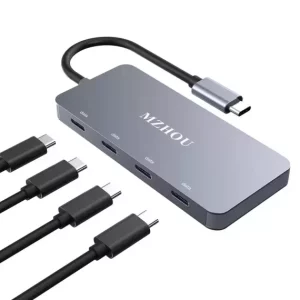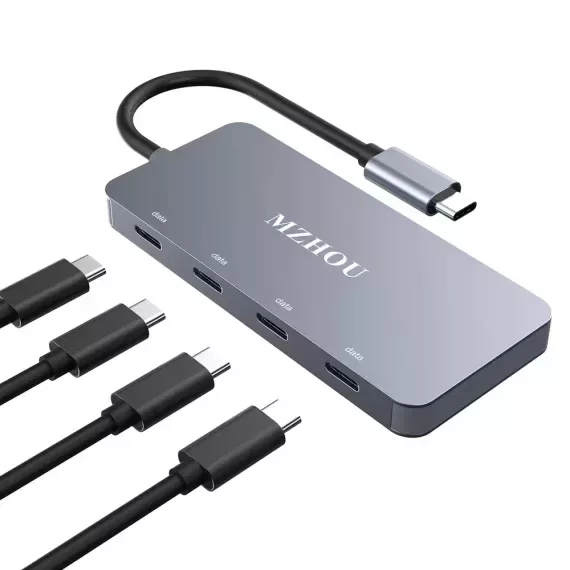USB-C and Thunderbolt are often confused due to their identical connector shapes and overlapping functionalities, but they are fundamentally different technologies. While USB-C refers primarily to the physical connector standard, Thunderbolt encompasses a set of data transfer protocols, power delivery specifications, and expanded capabilities layered on top of or integrated with the USB-C interface. Understanding the distinction between these two is critical for selecting the right equipment, ensuring compatibility, and maximizing device performance.
Understanding USB-C
USB Type-C, commonly known as USB-C, is a specification for a reversible 24-pin connector for USB devices and USB cabling. It defines only the physical form factor and connection standard, without mandating specific communication protocols or power capabilities. USB-C supports multiple USB standards, including USB 2.0, USB 3.2, and USB4, depending on the specific implementation.
Key characteristics of USB-C include:
- Reversible Design: The connector can be inserted either way, eliminating orientation errors.
- Power Delivery: USB-C supports USB Power Delivery (USB PD), allowing devices to charge at up to 240 watts (48V/5A) with the latest specifications.
- Alternate Modes: The connector can support alternate signal modes such as DisplayPort or HDMI, enabling video output through the same port.
Despite these versatile features, the performance of a USB-C port depends entirely on the underlying technology—meaning a USB-C port could offer anything from basic USB 2.0 speeds to advanced 40Gbps USB4 transfer rates.

Understanding Thunderbolt
Thunderbolt is an Intel-developed hardware interface that combines PCI Express (PCIe) and DisplayPort (DP) into a single serial signal alongside DC power. Thunderbolt versions, specifically Thunderbolt 3 and Thunderbolt 4, have adopted the USB-C connector, leading to common confusion.
Key features of Thunderbolt include:
- High Data Transfer Rates: Thunderbolt 3 and 4 offer speeds up to 40Gbps, significantly higher than traditional USB 3.2 (up to 20Gbps).
- Daisy-Chaining: Thunderbolt supports connecting multiple devices (up to six) through a single port in a chain, reducing cable clutter.
- Dual Protocol Support: Thunderbolt can carry both PCIe and DisplayPort protocols simultaneously, allowing external GPUs, fast storage, and multi-monitor setups through a single connection.
- Backward Compatibility: Thunderbolt 3 and 4 are backward compatible with USB standards, meaning they can operate as USB-C ports if required.
In essence, while Thunderbolt 3 and 4 use the USB-C form factor, they layer additional, significantly more advanced capabilities on top of it.

Key Differences Between USB-C and Thunderbolt
| Feature | USB-C | Thunderbolt 3/4 |
| Physical Connector | USB-C | USB-C |
| Data Transfer Rate | 480Mbps to 40Gbps (depends on USB version) | Always up to 40Gbps |
| Video Output | Possible via Alternate Mode (DisplayPort) | Integrated DisplayPort 1.4, supports multiple displays |
| Power Delivery | Up to 240W (USB PD) | Up to 100W typically (some variations) |
| Protocol Support | USB data, DisplayPort Alternate Mode | PCIe, USB data, DisplayPort combined |
| Daisy Chaining | No | Yes (up to 6 devices) |
| Certification | Varies by manufacturer | Strict Intel certification required |
One fundamental takeaway is that while all Thunderbolt 3 and 4 ports are USB-C, not all USB-C ports are Thunderbolt.
Practical Implications for Users
The difference becomes critical in scenarios requiring high-speed data transfer, such as connecting external graphics cards (eGPU), fast SSDs, professional audio interfaces, or multiple 4K monitors. A USB-C-only port without Thunderbolt capabilities would not be able to handle PCIe-based devices or deliver multi-stream video output at high resolutions and frame rates.
For example, a USB-C port supporting only USB 3.2 Gen 1 would provide a maximum of 5Gbps, far below the 40Gbps needed for connecting ultra-fast external storage or running dual 4K monitors. Therefore, users involved in professional video editing, 3D rendering, gaming, or data-intensive tasks should prioritize Thunderbolt-enabled devices.
Compatibility Considerations
Not all cables and peripherals that fit into a USB-C port will function optimally if Thunderbolt capabilities are required. Certified Thunderbolt 3 or 4 cables are designed to handle 40Gbps data rates, support active data transmission over longer distances, and safely carry high power loads. Using a non-certified USB-C cable can result in limited functionality, reduced speeds, or even device malfunction.
Furthermore, devices with a USB-C physical port may not necessarily support Thunderbolt, and vice versa. Users should always verify port capabilities by checking the device specifications or looking for the Thunderbolt logo—a lightning bolt symbol—next to the port.

Evolution Toward USB4
The USB4 specification, finalized in 2019, merges elements of Thunderbolt 3 into the USB ecosystem. USB4 devices must support at least 20Gbps speeds and optionally up to 40Gbps, with built-in support for PCIe and DisplayPort protocols. Nevertheless, native Thunderbolt 3 compatibility in USB4 devices is optional, and many USB4 implementations may not fully replace the capabilities of true Thunderbolt 3 or 4 systems.
Thus, while USB4 and Thunderbolt are converging, significant distinctions remain for critical applications, particularly those demanding stable, high-bandwidth connections.
USB-C and Thunderbolt, despite their physical similarities, are distinct in terms of capability, performance, and intended use cases. USB-C defines a versatile connector and cabling system, while Thunderbolt layers advanced data, video, and power protocols onto the same connector. Recognizing these differences is essential when selecting devices, accessories, and cables to ensure optimal performance, compatibility, and longevity for modern computing systems.





